If you are the type that have a curious mind like mine, wondering about the extent of differences among living organisms is a frequent thought that will occasionally travel through your mind. Let us set the argument between evolution and creationism aside. Both have a point of convergence which is that humans came from a single source; the pro-evolution scientists and the pro-creationists agree that humans came from a single source. If all the races of this world come from a single person, then why exactly are we different?
Generally, if the chemosynthetic theory of origin of life were to be true (is it not?), it means all living organisms, be it plant, protist, moneran, fungi or animal came from a single source. If the theory of organic evolution were also to be followed, it states that all living organisms as we have them now came into existence as a result of descent, with modification from common ancestor. That is to say, humans, gibbons, orangutans, apes, reptiles, amphibians and fishes all share a common ancestor. What exactly triggers these differences that gives rice to different organisms? Well, the answer could not be far fetched from this write up.
The chromosome structure
In my previous posts, the theory of central dogma was extensively discussed in which DNA occupies a central portion in the transfer of genetic information within the cell. The DNA is found in the nucleus and organelles like mitochondrion and chloroplast in the eukaryotic organisms. Upon close examination of the nucleus, this DNA and associated genetic materials in form of proteins are arranged and packed into a thread-looking structure called chromosomes. These chromosomes are not visible to ordinary eyes when the nucleus is viewed under the microscope unless the cell is actively dividing. At the beginning of cell division, the genetic materials within the nucleus condenses and thickens and can eventually be seen as been made up of chromosomes.
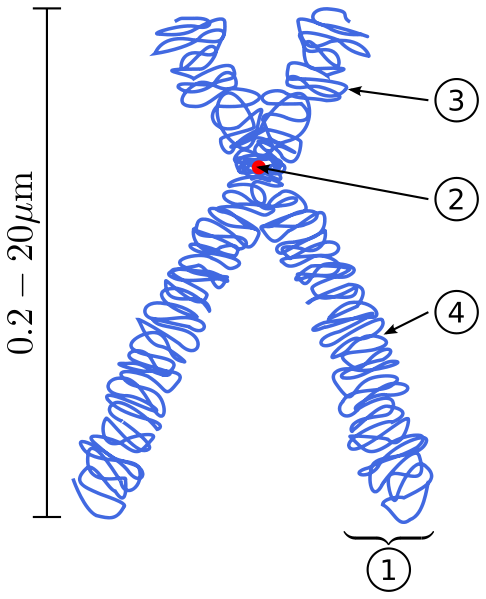
The chromosome of all living organisms are quite similar in structure. On a closer examination, the structure consist of somehow central constriction known as the centromere. The centromere divides the chromosome into two arms - the long arm (q arm) and the short arm (p arm). Each chromosome consists of sister chromatids joined together at this same centromere.
Chromosome varies in shape, size and form. Chromosome in the same cell may vary in size or they may be equal to sub-equal in overall size. A particular chromosome may also vary in size from one cell to another, although its size relative to others in the same cell may be remain constant. The size of chromosome of related species may differ such that the chromosome of one species are visibly larger than those of others.
The position of centromere along chromosomes determines the shape of the chromosome. When the centromere is located at the tip of the two sister chromatids, such chromosome is described as telocentric. Such chromosomes look long and rod-like. Acrocentric chromosomes have the centromere located at one end such that the two arms of the chromosomes are of unequal lengths. When the centromere is located close to the center of the chromosome, such chromosome is described as sub-metacentric. At times, the centromere is located at the center of the chromosome, giving it a 'V' shape with the length of the two arms being equal; such chromosome is described as being metacentric.
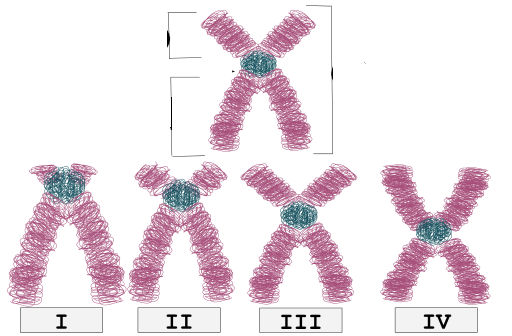
Chromosome rearrangement and genetic evolution
Chromosomes of all living organisms are made of DNA which contain genes that express characters organisms. The points on the chromosomes which genes are located are called loci. The sequence of genes on chromosomes are sacrosanct for expressing different traits, a little rearrangement can cause a great change in the physical appearance of organisms. One of the most important attributes of chromosomes is that they do undergo simple or multiple breakages. These breakages are known to occur spontaneously in nature and have played a significant role in the process of evolution and diversity of living organisms. Breakages can also be induced by extraneous agents such as ionizing radiations and chemicals such as nitrogen mustard, hydrazides, potassium cyanide among many others. This is one of the reasons humans are warned to stay away from radiations as much as possible.
It is quite characteristic of chromosomes that broken ends may heal or join other broken ends on the same chromosome, on homologous chromosome or on a non-homologous chromosome. Chromosome rearrangement are classified into 4 groups namely:
- deletions
- duplications
- translocations
- inversion
All of the arrangements depend on at least one breakage. The original chromosome before breakage is called the standard while the resultant chromosome is called deficient, duplicated, translocated or inverted depending on the nature of rearrangement.
chromosome deletions
Deletion of chromosome is the loss of chromosome segment. An organism may be homozygous or heterozygous for this deficiency. Organisms carrying deficient chromosomes lack the genes on the chromosomal segment that is absent resulting in a mutant phenotype. This kind of chromosome rearrangement is found in human with a special type of leukemia associated with deficiency in the long arm of chromosome 21. The cat-like cry syndrome(cri du chat) in human infants is also associated with a deficiency in the short arm of chromosome 5.

Duplication
Duplication is the presence of two identical chromosomal segments on the same chromosome. If a gamete carrying a chromosome with a duplicated segment is fertilized by an identical gamete, homozygosity for the duplicated segment results. A manifestation of this chromosome rearrangement is found to produce Lepore hemoglobin syndrome in humans.
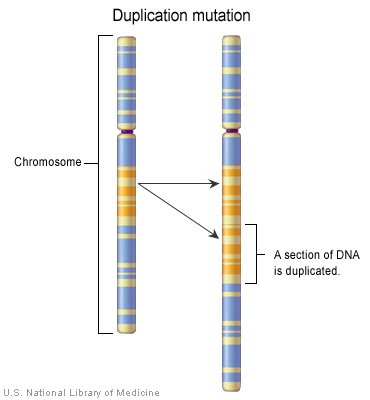
Translocation
The transfer of a chromosome segment from its original position to another is known as translocation. Two chromosomes can interchange position to result in what is known as reciprocal translocation. Simple translocation occurs when there is a shift in the position of chromosomal segments.
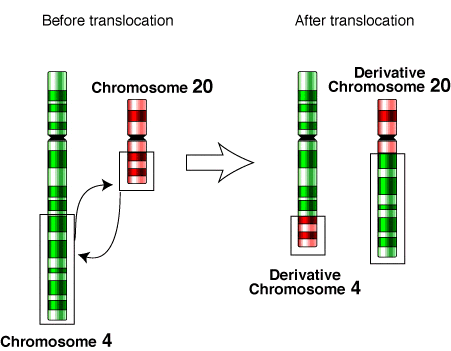
Evolution and genetic variability in many organisms are known to have been accompanied by complex translocation systems. One of the most important consequences of translocations is that chromosome rearrangements may arise and since the individuals homozygous for these arrangements are often intersterile with the standard, the evolution of two entities become independent. Down's syndrome in man is known to have resulted from the translocation of the long arm of chromosome 21 to the short arm of chromosome 14.
Inversion
Chromosomal inversion means a complete reversal of the order of genes in the affected segment. when the inverted segment include centromere, such inversion is said to be pericentric. Otherwise, it is paracentric. Inversion can also be terminal or interstistial.
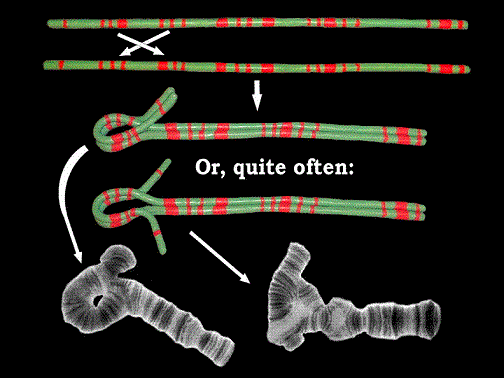
Summary
The DNA in living organisms are arranged in form of chromosome which carries the genes that are responsible for traits. The order of arrangement of the genes on the chromosome is important. A slight change in order might result in a big change in physical appearance of organism. Chromosome rearrangement is one of the ways in which genetic variability is sustained in nature. Variability in the genetic components of organisms leads to variation in physical appearance which is the basis on which evolution is built. Chromosome arrangements can come in form of deletions, duplications, translocations and inversions. These processes can occur in nature or be induced by certain radiations and or chemicals.
Thanks to everyone for the supports in form of comments, contributions and upvoting. Special shout out to the steemstem management team, you guys are doing an inhuman job.
References
biology.kenyon
free dictionary
britannica
medicinenet
easy biology class
US national library of medicine
biology discussion
NIH
science direct
Congratulations @hadji! You have completed some achievement on Steemit and have been rewarded with new badge(s) :
Click on any badge to view your own Board of Honor on SteemitBoard.
For more information about SteemitBoard, click here
If you no longer want to receive notifications, reply to this comment with the word
STOPWhy would anyone think that?
Downs syndrome is caused by any extra genetic material relative to chromosome 21, and is usually caused by a chromosomal duplication event resulting in their being 3 copies of that chromosome rather then the inversion event you describe here.
Why would anyone think that all the races of this world came from a single person? well, the chemosynthetic theory of origin of life and the evolution theory actually trolled that line. Chemosynthetic theory believes the first cell arose through mixture of chemical substances that were constituents of primitive atmosphere and that other cells arose from it. The evolutionists believes that organisms arose from a common ancestor but developed through different adaptive radiations.
Probably there are different genetic mechanisms behind down syndromes. I will read up :)
@ hadji very insightful,An inversion is a chromosome rearrangement in which a segment of a chromosome is reversed end to end. An inversion occurs when a single chromosome undergoes breakage and rearrangement within itself. Inversions are of two types: paracentric and pericentric.
Thanks a bunch for throwing more light on the post.